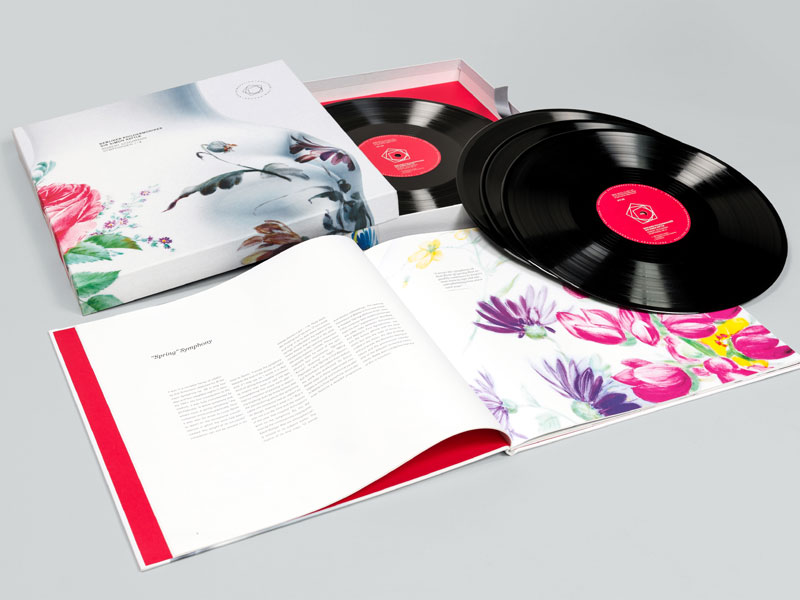The Vinyl Revival Reaches Current Classical Releases
hese days, if you want to listen to classical music on vinyl (still the best way), absent an extensive existing collection or a generous/vulnerable elderly relative who has one, you really have only two choices:
But things may be about to change. Recently, three of the world’s leading orchestras have released "own-label" recordings on vinyl. The San Francisco Symphony started the ball rolling with an ambitious collector’s item: a 23-disc boxed set chronicling Michael Tilson-Thomas’s complete Mahler symphonic cycle that costs a not-inconsiderable -- but not-unreasonable, given the sheer number of discs involved -- $749. Perhaps more relevant and certainly more approachable are offerings from the Berliner Philharmoniker and London Philharmonic: Rattle’s four Schumann symphonies from the former (below, €139) and Jurowski’s scintillating reading of the Brahms symphonies (£85) from the latter. Of course, orchestras the world over have been filling the funding gap left by the demise of major-label recording contracts by issuing their own CDs and SACDs, lately joined by live streaming and cinema broadcast options. But the move into vinyl is as new as it is welcome. Here we have current recordings of the best contemporary orchestras performing complete sets of key, core repertoire -- works that have all been poorly and at best sporadically served by the audiophile reissue labels. These sets are all beautifully presented, their packaging matching the best examples from the golden age of vinyl records, with pristine, ruler-flat discs and copious notes. Online images don’t do these boxes justice; they really are much more impressive in the flesh. However, audiophile naysayers will be quick to point out that these records are all pressed from digital tapes (rather than the purist, analog alternative) and that the recordings themselves are already available, considerably cheaper in various digital-disc and download formats. So why would you bother with these vinyl boxed sets?
The answer really is as simple as "Because they are on vinyl!" Let me explain. The material cost and editing time involved in making current recordings on analog tape are simply not supportable. Remember, the object of the exercise is that sales of the recordings help support the orchestra, so it’s self-defeating if the cost of production is so high that sales are non-existent. But even so, the fact that these discs are drawn from digital masters is far from the disaster many analog diehards might assume. Not only has digital recording come an awful long way from its pre-CD debut, both in terms of technology and specific experience and expertise, but the very fact that these recordings have been transferred to vinyl invests them with certain sonic and musical advantages. The replay chain for a vinyl record is very different to the mix of mechanics and electronics used to lift a signal from a CD or replay a music file in the domestic environment. It certainly involves its own challenges and problems, but those flaws tend to be less musically intrusive than the ones found in all-digital replay systems. Perhaps more critically, most record players outperform their digital cost equivalents when it comes to musical performance. Add to that the fact that the sort of dedicated vinyl listeners who will buy these boxed sets will probably have invested considerably more in their record-replay chain than their digital one and the differential imbalance between record and CD/file replay gapes even wider. Throw in the beautifully executed artwork and the tactile superiority of a 12" vinyl disc over the beer-mat digital alternative, not to mention the almost mystical process of cueing up and replaying a record, rather than simply tapping at a touch screen, and these boxed sets constitute a musical and aesthetic slam dunk. Before we get too excited (and nobody’s holding his
breath on this one), one swallow doesn’t make a summer, and three boxed sets
don’t constitute a current classical vinyl revival or even scratch the surface of a
serious classical collection. We can only hope it’s a trend that continues and
flourishes -- and that will only happen if these records generate the necessary interest
and sales. You know what to do. I have, and if you care about and enjoy listening to music
on vinyl, you should too. I’ll be offering up full reviews of both the Berliner
Philharmoniker and London Philharmonic boxes, but as they are both limited editions, they
won’t be around forever. If you snooze, you might well lose. |

